This was published 3 years ago
‘These are battlefield tasks’: Defence Force on the ground for flood recovery
By Lucy Cormack and Wolter Peeters
Defence forces are on the ground helping with the recovery effort. Credit: Wolter Peeters
The big wet was just setting in over NSW last month when Colonel Warwick Young received the call.
It was Marg Prendergast, executive director of disaster recovery at Resilience NSW. The one in 50-year flood event had only just begun its wrath.
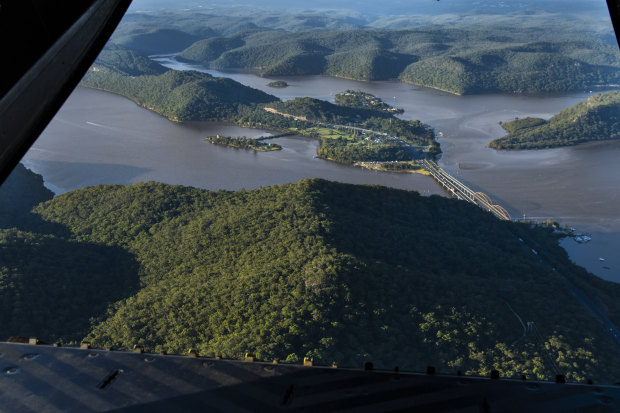
Floodwaters in the Hawkesbury River pass under Hawkesbury River Bridge at Mooney Mooney.Credit: Wolter Peeters
The army reservist of 30 years recalls: “Marg rang me and said, ‘We’re having a meeting. Can you be at it? Just so you are aware of what’s going on.’”
It was Sunday, March 21, one day before two powerful weather systems would collide over the east coast of NSW, causing widespread chaos, evacuations and the loss of a human life.
Sustained rainfall had already begun wreaking havoc on the Mid North Coast, where the Hastings River had peaked at 8.54 metres at Wauchope a day earlier.
Thousands of people were being evacuated from homes along the coast, Warragamba Dam was spilling billions of litres of water and communities in the Hawkesbury-Nepean region were inundated, many trapped.
To the state agencies tackling the crisis - Resilience NSW, the State Emergency Service, the NSW Rural Fire Service, NSW Health and police - it was only natural the army would join them.
Four days later Deputy Premier and the Minister responsible for disaster recovery John Barilaro would announce the mobilisation of a recovery strike force, made up of 800 Australian Defence Force personnel, the NSW Rural Fire Service and Fire and Rescue NSW.
Colonel Young, deputy commander of the Joint Task Group for NSW assigned to the recovery effort, said the relationship between the Defence Force and state agencies galvanised through the fires and were bedded down by COVID-19.
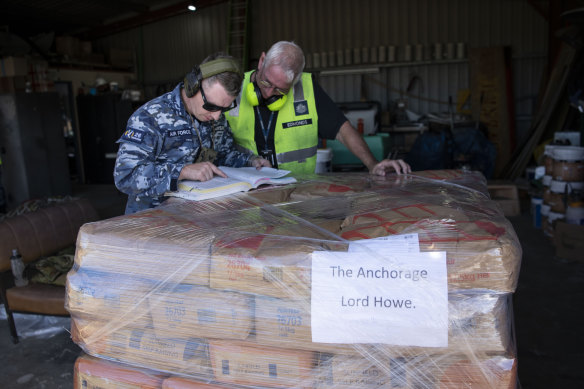
Supplies of flour and sugar destined for Lord Howe Island wait to be loaded at Port Macquarie Airport.Credit: Wolter Peeters
“By the time the flood came along, we had morphed into the whole of government response,” he said.
The group has since rolled out along the Mid North Coast; from Coffs Harbour, Bellingen and Clarence Valley, to Kempsey, Nambucca and Port Macquarie.
For locals, the 350 recently arrived troops are welcome figures overseeing the clearing of roads, 30 tonnes of waste and the repair of critical infrastructure.
One of the more urgent jobs this weekend will be delivering LPG gas and flour to holiday destination Lord Howe Island, after the destruction of a Port Macquarie facility used to barge food and supplies.
“These are battlefield tasks we’re well suited to... and it’s great for our soldiers, sailors, airmen and women to get in and help the community they love,” said Commander of the Joint Task Group Brigadier Mick Garraway.
They should be well practised, with many having managed the clean-up from the Black Summer bushfires, an unexpected dress rehearsal to the floods.
“We’ve got a really strong commitment that we will do no less for people affected by the floods, than we did for bushfires. And rightfully so,” said Ms Prendergast.
Among her biggest tasks is managing nine recovery centres dotted across flood-affected areas, which act as a one-stop-shop for victims seeking services like insurance, legal aid, council clean-up and mental health care.
”One of the big lessons from bushfires was ‘tell us once’. Instead of people having to tell their story over and over again. Now you register once,” she said.
“We have even got approval to share that data with people like the Red Cross to get grants out the door more quickly.”
‘We have faced droughts, fires, COVID, and now flood’
From the sky, Lieutenant Colonel Henry Stimson can see the hundreds of mattresses lining Laurieton Oval.
They are just some of the remains pulled from nearby homes over the past few days.
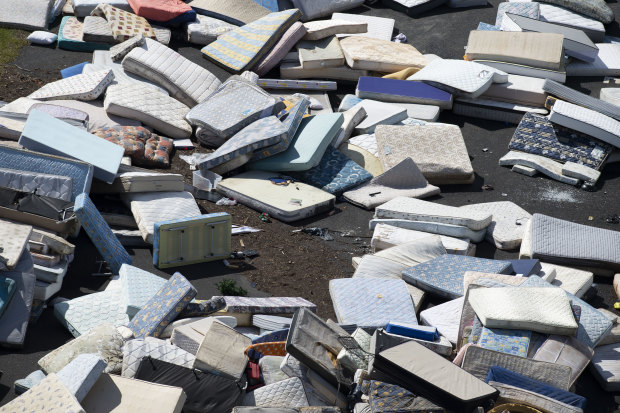
A pile of flood damaged mattresses at North Haven. Credit: Wolter Peeters
On a sunny Thursday, it’s hard to imagine it was only one week earlier that floodwaters of at least two metres coursed through homes streets away in North Haven.
Lieutenant Colonel Stimson lands on the rugby field in an MRH90 Taipan helicopter. He is on his way to check on troops clearing out flooded homes in Dunbogan, Laurieton and North Haven.
Toys, rugs and lounges are piled up along the kerb. When a strong wind blows the smell is pungent.
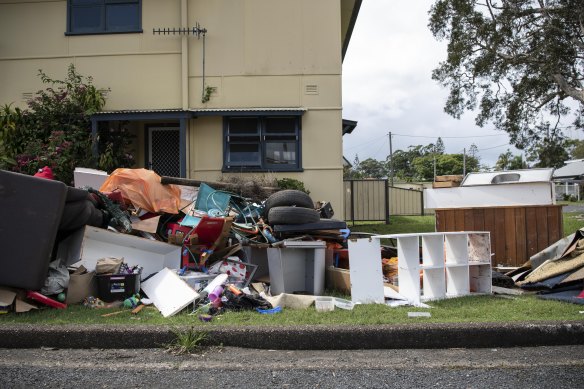
ADF personnel help clear flood damaged household items in North Haven.Credit: Wolter Peeters
Seventy kilometres north, in Kempsey, Mayor Liz Campbell says her community is still counting its losses, but slowly getting back on its feet.
“For the farmers downriver it will take a long time. Their pastures are still under mud and it will take six to 12 months to get that back,” she said.
From dairy farmers, to beef, coffee and bee producers, there are few in her community that haven’t felt the burn of a recent catastrophe.
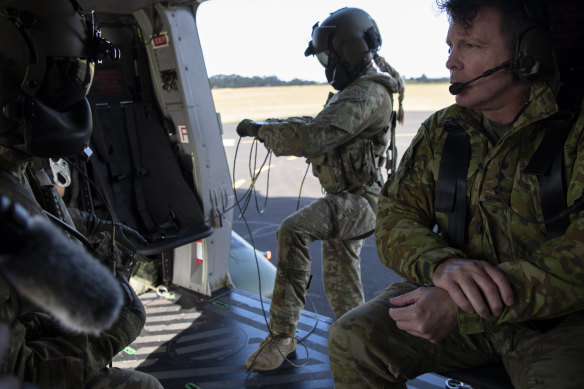
Colonel Warwick Young with ADF personnel prepare to depart Port Macquarie Airport. Credit: Wolter Peeters
“We have faced droughts, fires, COVID, and now flood. That’s not easy… but it’s made a huge difference that we had the ADF resource committed almost straight away, and there wasn’t a lapse.”
Ms Campbell said it was a huge step up from the fires, when Prime Minister Scott Morrison announced the ADF’s involvement before personnel had been notified.
Water Minister and local member for Oxley Melinda Pavey said seeing the Defence Force in town so quickly after the floods was a “godsend” for the community.
“For people to know they are not alone… seeing volunteers from all across NSW, coupled with personnel in army uniforms,” she said.
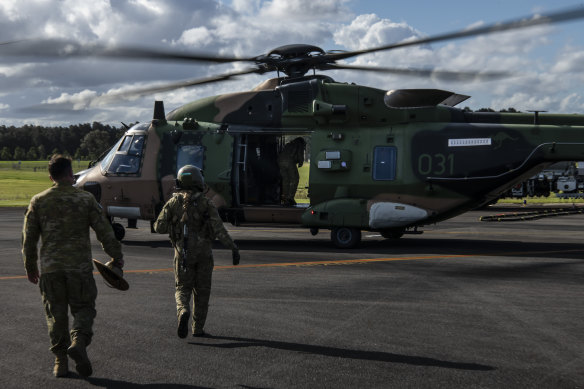
The Australian Defence Force has been assisting with the flood recovery efforts.Credit: Wolter Peeters
Ms Pavey said there had been valuable lessons learnt between the state and federal government since the bushfires, pushed along by advocacy from federal Nationals members Pat Conaghan and David Gillespie.
“They were very aware they needed to be part of a team effort to make things right.”
Politically, the floods saw Ms Pavey face off with Emergency Services Minister David Elliott, who accused her of being reluctant to release water from the full Warragamba dam to mitigate the big wet.
Ms Pavey has stressed strict protocols meant she had no power to alter dam levels, which would not have helped in any case.
“It was a rain and a flooding pattern we haven’t seen for decades and decades,” she said, pointing to the local service station at Telegraph Point: “60 years and it has never flooded.”
Locally she said it had been a painful two weeks for her electorate, including the community of Stuarts Point, where more than 45 homes were evacuated after the rain caused a widespread septic leak. Contaminated roads were disinfected and reopened on Tuesday.
Meanwhile, farming communities will face some of the longest uphill battles, as the ongoing clean-up exposes their once fertile pasture, now lost.
Ms Pavey said grants of up to $75,000 for primary producers to repair vital infrastructure may not cover all losses, but they will stop many farmers from going under.
‘It’s sort of what you signed up for’
Lieutenant Colonel Stimson’s next chopper stop is Kempsey Airport, before a 45-minute drive to the remote community of Toorumbee.
Barely a dot on the map, the tiny community of 30 houses is set deep in bushland along a dirt road. It is the same landscape that in November 2019 was scarred by fire that ripped through the Boonanghi State Forest.
One of only two access roads was cut off during the fire and remains inaccessible today, meaning the Toorumbee community was entirely cut off when floodwaters and debris blocked the only other road out.
Lieutenant Fraser Jeavons is overseeing the spreading of new gravel to widen and reconnect the final section of the road.
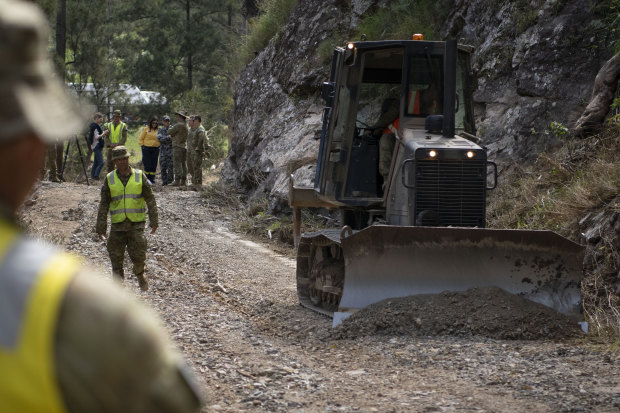
ADF personnel have been clearing and regrading the flood-damaged Toorumbee Road.Credit: Wolter Peeters
He said he’s keen to see the job finished for one resident, in particular, a Kempsey teacher who is walking seven kilometres to an accessible road, before she can drive to school.
“Helping the local community, it’s sort of what you signed up for,” he said.